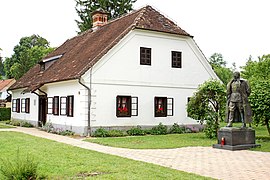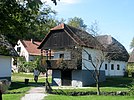Kumrovec (Croatian pronunciation: [kûmroʋet͡s]) is a village in the northern part Croatia, part of Krapina-Zagorje County. It sits on the Sutla River, along the Croatian-Slovenian border. The Kumrovec municipality has 1,413 residents (2021), but the village itself has only 267 people.[3] The municipality was established on May 6, 1997, after it was split from the municipality of Tuhelj.
Kumrovec | |
|---|---|
| Coordinates: 46°5′8″N 15°40′40″E / 46.08556°N 15.67778°E | |
| Country | |
| County | |
| Government | |
| • Municipal Mayor | Robert Šplajt (HNS) |
| • Council | 11 members |
| Area | |
| • Municipality | 17.5 km2 (6.8 sq mi) |
| • Urban | 2.1 km2 (0.8 sq mi) |
| Population (2021)[2] | |
| • Municipality | 1,412 |
| • Density | 81/km2 (210/sq mi) |
| • Urban | 245 |
| • Urban density | 120/km2 (300/sq mi) |
| Time zone | UTC+1 (CET) |
| • Summer (DST) | UTC+2 (CEST) |
| Website | kumrovec |
Kumrovec is notably the birthplace of Josip Broz Tito (1892–1980), the president of former Yugoslavia. The birth house of Tito (built in 1860 as the first brickwork house in the village) features the Memorial Museum of Marshal Tito, opened in 1953. The museum is also important for the local folklore. Next to the house is the bronze standing statue of Marshal Tito (made by Antun Augustinčić, 1948). The old part of Kumrovec comprises the Ethnological Museum with 18 village houses, displaying permanent exhibitions of artifacts related to the life and work of Zagorje peasants in the 19th/20th century. The village is small but of great popularity in the former Yugoslavia, owing to the annual celebration of Youth Day every May 25.[4]
Today the major attraction of Kumrovec is the Ethnological Museum Staro Selo (Old Village) Kumrovec with very well preserved village houses from the turn of 19th/20th century. The reconstruction and redecoration of these houses started in 1977. So far 40-odd houses and other farmstead facilities have been restored, which makes Staro Selo the most attractive place of this kind in Croatia. Visitors may see permanent ethnological exhibitions such as the Zagorje-style Wedding, the Life of Newly-weds, From Hemp to Linen, Blacksmith's Crafts, Cart-wright's Craft, Pottery, From Grain to Bread, etc.
On November 24, 1935, the Brethren of the Croatian Dragon raised a monument to the Croatian anthem Lijepa naša domovino to celebrate its one hundredth anniversary. Kumrovec celebrates this day as its municipal holiday.[5]
History
editIn the late 19th and early 20th century, Kumrovec was part of Varaždin County of the Kingdom of Croatia-Slavonia.
According to the research of Slovenian historian Daniel Siter, during the initial phase of the German occupation of the Slovene-Croatian territory between May and June 1941, the municipality of Kumrovec was temporarily occupied by Nazi Germany, along with other parts of the western outskirts of the Croatian Zagorje (Hum na Sotli, Prišlin, Druškovec, Brezno and Lupinjak). For the first few weeks after the occupation in April, the swastika also hung in Kumrovec. The occupied territory of Western Croatian Zagorje (including Kumrovec) was returned to the Independent State of Croatia in mid-June 1941. At that time, the state and occupation border between Germany and Croatia was finally established along the water line of the Sotla river.[6][7]
Culture
editThe municipality is home to the cultural organization KUD Kumrovec.[8] It has two Catholic chapels: Kapela sv. Rok built in 1963 and Kapela Majke Božje Snježne built in 1639.[9]
Population
editAccording to the 2011 census, the municipality had a total population of 1,588 in ten separate settlements:[3]
- Donji Škrnik (pop. 169)
- Dugnjevec (pop. 67)
- Kladnik (pop. 155)
- Kumrovec (pop. 267)
- Podgora (pop. 45)
- Ravno Brezje (pop. 216)
- Razdrto Tuheljsko (pop. 97)
- Razvor (pop. 191)
- Risvica (pop. 277)
- Velinci (pop. 104)
Gallery
edit-
Marshal Tito's birth house
-
Tito's statue in Kumrovec, made by the sculptor Antun Augustinčić (1900-1979)
-
Monument to the Croatian anthem
-
Monument to the fallen fighters of the National Liberation struggle in the area of Kumrovec
-
One of the scenes at the Ethnological Museum in Kumrovec
-
Former Communist Party of Yugoslavia political school in Kumrovec.
References
edit- ^ Register of spatial units of the State Geodetic Administration of the Republic of Croatia. Wikidata Q119585703.
- ^ "Population by Age and Sex, by Settlements" (xlsx). Census of Population, Households and Dwellings in 2021. Zagreb: Croatian Bureau of Statistics. 2022.
- ^ a b "Population by Age and Sex, by Settlements, 2011 Census: Kumrovec". Census of Population, Households and Dwellings 2011. Zagreb: Croatian Bureau of Statistics. December 2012.
- ^ "Several Thousand Admirers of Tito Celebrate Day of Youth in Kumrovec". Total Croatia News. 21 May 2022. Retrieved 15 July 2022.
- ^ "Kumrovec". tzkzz.hr (in Croatian). Archived from the original on 17 April 2015. Retrieved 17 April 2015.
- ^ Siter, Daniel (2023). Rogaška Slatina pod kljukastim križem: zdravilišče med okupacijo 1941-1945 (2nd (supplemented and expanded) ed.). Ljubljana: Alma Mater Europaea - Fakulteta za humanistični študij, Institutum Studiorum Humanitatis, Ljubljana. pp. 3–6, 55–61, 307–322. ISBN 978-961-6192-89-7.
- ^ Siter, Daniel (2019-08-26). "Reka Sotla kot okupacijska meja med nemškim rajhom in NDH: primer občine Rogaška Slatina". Kronika: časopis za slovensko krajevno zgodovino (Letn. 67, št. 1 (2019)): 141–164. ISSN 0023-4923. Retrieved 2023-09-20.
- ^ "KUD Kumrovec". kumrovec.hr. Retrieved 6 September 2015.
- ^ Kumrovec Archived March 27, 2009, at the Wayback Machine
Further reading
edit- Siter, Daniel [in Slovenian] (2019). "Reka Sotla kot okupacijska meja med nemškim rajhom in NDH: primer občine Rogaška Slatina". Kronika: časopis za slovensko krajevno zgodovino (in Slovenian). 67 (1): 141–164. ISSN 0023-4923. COBISS 69148258.
- Siter, Daniel [in Slovenian] (2023). Rogaška Slatina pod kljukastim križem: Zdravilišče med okupacijo 1941–1945 (2 ed.). Ljubljana: Alma Mater Europaea, Institutum Studiorum Humanitatis. ISBN 978-961-6192-89-7. COBISS 143986691.







